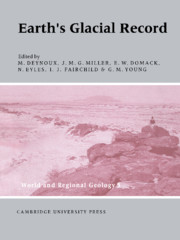Book contents
- Frontmatter
- Contents
- List of contributors
- Preface
- Acknowledgements
- 1 Geodynamic controls on glaciation in Earth history
- 2 Glacial-marine facies in a continental rift environment: Neoproterozoic rocks of the western United States Cordillera
- 3 The Neoproterozoic Konnarock Formation, southwestern Virginia, USA: glaciolacustrine facies in a continental rift
- 4 Glaciogenic deposits of the Permo-Carboniferous Dwyka Group in the eastern region of the Karoo Basin, South Africa
- 5 Itararé Group: Gondwanan Carboniferous-Permian of the Paraná Basin, Brazil
- 6 The interpretation of massive rain-out and debris-flow diamictites from the glacial marine environment
- 7 Neoproterozoic tillite and tilloid in the Aksu area, Tarim Basin, Uygur Xinjiang Autonomous Region, Northwest China
- 8 Lithology, sedimentology and genesis of the Zhengmuguan Formation of Ningxia, China
- 9 Architectural styles of glacially influenced marine deposits on tectonically active and passive margins
- 10 Marine to non-marine sequence architecture of an intracratonic glacially related basin. Late Proterozoic of the West African platform in western Mali
- 11 The enigmatic Late Proterozoic glacial climate: an Australian perspective
- 12 Isotopic signatures of carbonates associated with Sturtian (Neoproterozoic) glacial facies, central Flinders Ranges, South Australia
- 13 Reactive carbonate in glacial systems: a preliminary synthesis of its creation, dissolution and reincarnation
- 14 A Permian argillaceous syn- to post-glacial foreland sequence in the Karoo Basin, South Africa
- 15 A palaeoenvironmental study of black mudrock in the glacigenic Dwyka Group from the Boshof-Hertzogville region, northern part of the Karoo Basin, South Africa
- 16 Late Paleozoic post-glacial inland sea filled by fine-grained turbidites: Mackellar Formation, Central Transantarctic Mountains
- 17 Ice scouring structures in Late Paleozoic rhythmites, Paraná Basin, Brazil
- 18 Soft-sediment striated surfaces and massive diamicton facies produced by floating ice
- 19 Environmental evolution during the early phase of Late Proterozoic glaciation, Hunan, China
2 - Glacial-marine facies in a continental rift environment: Neoproterozoic rocks of the western United States Cordillera
Published online by Cambridge University Press: 06 July 2010
- Frontmatter
- Contents
- List of contributors
- Preface
- Acknowledgements
- 1 Geodynamic controls on glaciation in Earth history
- 2 Glacial-marine facies in a continental rift environment: Neoproterozoic rocks of the western United States Cordillera
- 3 The Neoproterozoic Konnarock Formation, southwestern Virginia, USA: glaciolacustrine facies in a continental rift
- 4 Glaciogenic deposits of the Permo-Carboniferous Dwyka Group in the eastern region of the Karoo Basin, South Africa
- 5 Itararé Group: Gondwanan Carboniferous-Permian of the Paraná Basin, Brazil
- 6 The interpretation of massive rain-out and debris-flow diamictites from the glacial marine environment
- 7 Neoproterozoic tillite and tilloid in the Aksu area, Tarim Basin, Uygur Xinjiang Autonomous Region, Northwest China
- 8 Lithology, sedimentology and genesis of the Zhengmuguan Formation of Ningxia, China
- 9 Architectural styles of glacially influenced marine deposits on tectonically active and passive margins
- 10 Marine to non-marine sequence architecture of an intracratonic glacially related basin. Late Proterozoic of the West African platform in western Mali
- 11 The enigmatic Late Proterozoic glacial climate: an Australian perspective
- 12 Isotopic signatures of carbonates associated with Sturtian (Neoproterozoic) glacial facies, central Flinders Ranges, South Australia
- 13 Reactive carbonate in glacial systems: a preliminary synthesis of its creation, dissolution and reincarnation
- 14 A Permian argillaceous syn- to post-glacial foreland sequence in the Karoo Basin, South Africa
- 15 A palaeoenvironmental study of black mudrock in the glacigenic Dwyka Group from the Boshof-Hertzogville region, northern part of the Karoo Basin, South Africa
- 16 Late Paleozoic post-glacial inland sea filled by fine-grained turbidites: Mackellar Formation, Central Transantarctic Mountains
- 17 Ice scouring structures in Late Paleozoic rhythmites, Paraná Basin, Brazil
- 18 Soft-sediment striated surfaces and massive diamicton facies produced by floating ice
- 19 Environmental evolution during the early phase of Late Proterozoic glaciation, Hunan, China
Summary
Abstract
Diamictite-bearing strata present in Neoproterozoic successions in the Death Valley area of southeastern California, northern Utah, and southeastern Idaho, USA record glacialmarine sedimentation. Though no radiometric dates have been obtained from these rocks, lithostratigraphic correlations suggest that they were deposited during the Sturtian (Rapitan) glacial epoch. These strata were deposited within and along the margins of a number of differentially subsiding basins that are inferred to have developed between 780 and 730 Ma, during an episode of rifting that preceded the formation of a passive continental margin in latest Neoproterozoic or early Cambrian time.
Three diamictite-bearing associations of sedimentary facies are recognized. The massive diamictite association is interpreted to represent rain-out and/or redeposition by sediment gravity flow, of debris derived from a partially floating or disintegrating ice sheet, perhaps near its grounding line, in the absence of bottom currents. Two bedded diamictite-bearing facies associations are recognized. The stratified diamictite and graded sandstone association includes heterogeneous diamictite, graded sandstone, bedded conglomerate and grit, as well as fine-grained strata including rhythmite and dropstone-bearing laminite. It is interpreted to include subwave base sediment gravity flow deposits, in part redistributed by thermo-haline currents, with a variable component of ice-rafting. Generally this facies represents more ice-distal or basinal paleogeographic settings than the massive diamictite association. The diamictite and laminated sandstone association contains heterogeneous diamictite and distinctive, texturally mature, massive to parallellaminated sandstone beds. It is interpreted to represent ice-proximal deposits which form in the presence of subglacial or glacialfluvial meltwater. Two non-glacial facies associations are recognized: the carbonate, shale and sandstone association (mainly marine), and the cross-bedded sandstone association (fluvial).
- Type
- Chapter
- Information
- Earth's Glacial Record , pp. 29 - 46Publisher: Cambridge University PressPrint publication year: 1994
- 11
- Cited by



